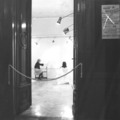The most important image that has remained with me is that of a chair that Tamás St.Auby put out on the sidewalk at the time (Tamás Szentjóby: Sit out in front of the Duna Inter-Continental Hotel in 1972). It was prohibited to sit in public space. Those who sat outside were considered slackers evading work. From my point of view, this indicates emblematic, silent resistance and the passing of time. We simply have to think about how many lie, sit, beg and sell things on the sidewalk since then.
The other group of events that I would mention is the actions of the Inconnu group, both in the era and today. The group formed in 1978, engaged then in mail-art, in order to avoid censorship, wrote a fake address for the addressee, and wrote the actual addressee as the sender. The censored post was forwarded to the “sender” with an “address unknown” or “inconnu” stamp, while this identity was not checked. It reveals how much change history caused that the Inconnu group was one of the organisations that, reacting recently to the former prime minister’s, Ferenc Gyurcsány’s speech in Öszöd, demonstrated for months in front of the Parliament with right-wing groups, joining up with the so-called "Kossuth-Squareians".
I thought to mention these two cases – Tamás St.Auby’s work because it is closest to me, and the Inconnu group because I imagine that no one else will mention them, and their place is certainly in a historical archive.
Róza El-Hassan, artist born in 1966
2009.06.18.
Szólj hozzá!
Comments
A bejegyzés trackback címe:
https://exhibition-history.blog.hu/api/trackback/id/tr41192446
Kommentek:
A hozzászólások a vonatkozó jogszabályok értelmében felhasználói tartalomnak minősülnek, értük a szolgáltatás technikai üzemeltetője semmilyen felelősséget nem vállal, azokat nem ellenőrzi. Kifogás esetén forduljon a blog szerkesztőjéhez. Részletek a Felhasználási feltételekben és az adatvédelmi tájékoztatóban.
Nincsenek hozzászólások.

 tranzit is a contemporary art program supported by the Erste Bank Group
tranzit is a contemporary art program supported by the Erste Bank Group

 The exhibition Parallel Chronologies and the symposium The Invisible
History of Exhibitions is part of the international project Art Always Has
Its Consequences co-financed by the Culture 2007 program of the European
Union (partners: WHW Zagreb, tranzit. hu, Muzeum Sztuki Łódź, kuda.org
Novi Sad).
The exhibition Parallel Chronologies and the symposium The Invisible
History of Exhibitions is part of the international project Art Always Has
Its Consequences co-financed by the Culture 2007 program of the European
Union (partners: WHW Zagreb, tranzit. hu, Muzeum Sztuki Łódź, kuda.org
Novi Sad).








Utolsó kommentek